Desert Air War Group build: 1/48 Eduard Spitfire Vb(late)
The Airplane:
The Spitfire Vb, which began appearing in squadrons in the spring of 1941, was the most-produced Spitfire sub-type. It was a modification of the Spitfire I airframe, “beefed up” with a new engine mount, to use the Merlin 45 engine. Other than the engine, it was similar (outside of small details) to the Spitfire IIb, armed with a drum-fed Oerlikon 20mm cannon in each wing.
Ian R. Gleed in North Africa:
Ian Richard “Widge” Gleed, a doctor's son, was born in Finchley, London, on July 3, 1916. Educated at Tenterden Preparatory School and Epsom College, he learned to fly privately and flew his first solo at the London Aeroplane Club, Hatfield on November 16, 1935.
He joined the RAF on a short service commission in March 1936 and was commissioned an RAF Pilot Officer in March 1936 and posted to 46 Squadron at Kenley. 46 was flying Gauntlets at the time but transferred to Hurricanes in 1939.
On February 18, 1940, a Spitfire Gleed was testing broke up in mid-air. He was thrown out and lost consciousness. He came to, pulled his ripcord and the parachute opened. He came off flying and did not return to 266 until late April and was only allowed to fly dual. He regained full flying status on May 14, 1940.
Gleed was was promoted to Flight Lieutenant and joined 87 Squadron in France May 17, 1940. Between May 17-20, he scored 5 victories plus a share in another and 1 probable. 87 Squadron returned to England on May 20 to re-form and re-equip. On August 1, Gleed became the squadron leader. On August 15, he led the squadron into a large German formation and shot down two Bf-109s and a possible third. He scored 4 more before the end of the Battle of Britain and was awarded the Distinguished Flying Cross and later the Distinguished Service Order. He then led 87 in developing night fighting and night intruder tactics in the Hurricane.
He was appointed Wing Leader at Middle Wallop on November 18 and led the wing in the “lean into France” in the spring of 1941, finally coming off tour on July 16 and assigned to Fighter Command as Wing Commander Tactics, becoming Wing Commander Operations on December 7, 1942.
Gleed was sent to the Middle East in January 1943, where he flew briefly with 145 Squadron for operational experience, then led 244 Wing through the fighting in Libya and into Tunisia.
On an afternoon patrol on April 16, 1943, he led an attack on a formation of Ju-52 transports over Cape Bon, escorted by Bf-109s. During the fight, he was shot down, probably by Leutnant Reinert of JG 77.
After being hit, Gleed headed for the Tunisian coast. His Spitfire, AB502, was found on sand dunes near the sea on the western coastline of Cap Bon. His body was not found there but was found buried at Tazoghrane. He was reburied in the Military Cemetery at Enfidaville on April 25, 1944.
The Kit:
This Spitfire Vb (Late) is the other option in the dual combo limited release “Eagles Call” kit. It is a “late” Spitfire Vb in that the fuselage is molded to take the later windscreen with the internally-mounted armor glass windscreen. The lower wing has the correct fairing for the cannon drum for the Spitfire Vb, which differs from that of the Spitfire IIb.
I opted to do this as Ian R. Gleed's AB502, since I had the decals for it on “Spitfire: Aces of the Empire” and the kit provided the correct Aboukir filter for this airplane.
Construction:
If you follow the instructions and take your time, you will be rewarded with a really nice model. There are parts in this release for all Spitfire Vb sub-types, with both the Vokes and two types of Aboukir filters present.
I opted to assemble this kit by changing the method of attaching the wing. After assembling the gear well parts in the lower wing, I attached the lower wing to the completed fuselage, then attached the upper wing parts. I was able to get a nice tight fit without all the “pushing and shoving” one goes through if you assemble the wing sub-assembly completely and then mate it to the fuselage sub-assembly. I will be doing this always on all future Eduard Spitfires (and there will be more - these are great kits).
I used the Aboukir filter option that has the sharp angle in the lower nose panel that is correct for Gleed's airplane.
Painting:
Gleed's AB502 had a repaint at the Aboukir depot, which is an “approximation” of the “B” scheme. I had done this airplane before with the Hasegawa limited release 25 years ago, which had a detailed three-view painting diagram for AB502, and had taken photos from all angles of the completed model, which I referred to in painting this model. I used my mixtures for Tamiya paint to do Dark Earth, Middle Stone and Azure Blue, applied freehand with my Paasche-H using a No. 1 fine tip. I went back over each upper surface color three times, adding in first a bit of light grey, then a bit of yellow, and then white, to simulate sun-fading under the hot North African sun.
Decals:
I used the kit decals for the national markings, and the decals in “Spitfire: Aces of the Empire” for the individual markings. This sheet has Figaro the cat, which Gleed used as his personal symbol, tearing down an Afrika Korps palm tree, which is correct for AB502.
Final Finish and Assembly:
I gave the model several coats of clear flat varnish to get that “sun bleached” final finish, then applied exhaust staining as shown in photos of the airplane and added a few “dings” with Vallejo “Dull Aluminum.” I unmasked the canopy and posed it open, attached the landing gear and the Rotol prop.
Overall:
This kit is, again, “the best of its sub-type in 1/48 scale” as are all the Eduard Spitfires. Changing the method of wing assembly made things far easier, while getting a better final result. I recommend that assembly sequence to you. You'll like it. (I also bet this works with the P-51D and Tempest kits) There are a bazillion decal options for Spitfire Vbs in aftermarket decals, and I know this won't be the only model I build with this great kit.
Check out the WIP in the Desert Air War Group for in-progress reports and photos.
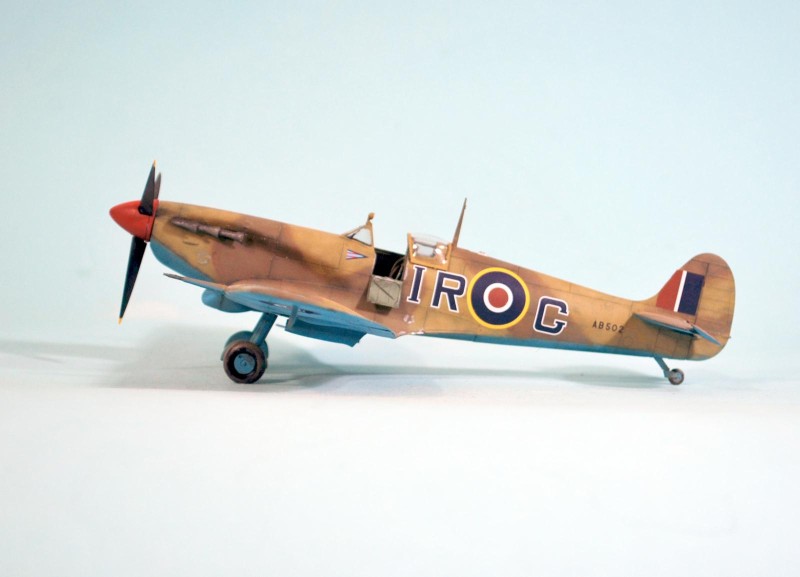
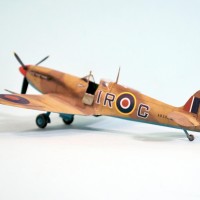
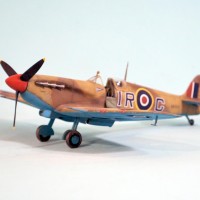
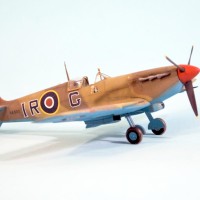
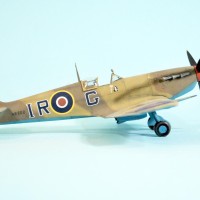
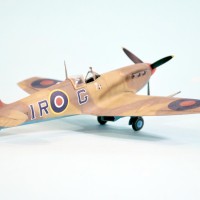
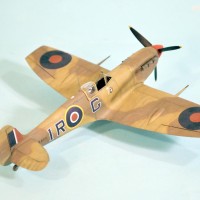
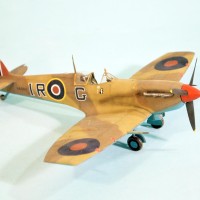
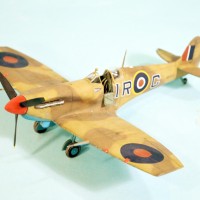
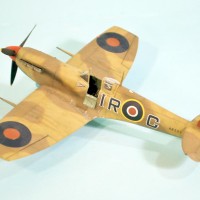

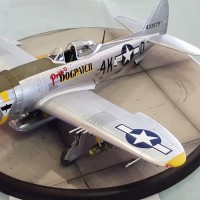
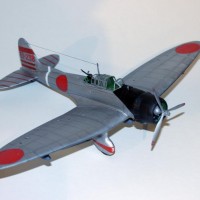
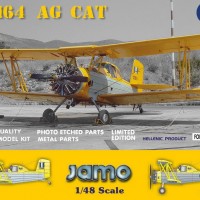
Another excellent, super quick build if the very good Eduard kit, Tom! Loved to read Ian R. Gleed's story, as well as the whole article.
Beautiful build and ditto story, Tom @tcinla
Thanks for the thread and for sharing the article about this build.
Great build and story! I hope I will build my Spitfire from 145 squadron.
Nice looking Plane and great tip for assembling the wings to fuselage.
Not familiar with Eduard kits but worth checking it out.
Beautiful Spitfire Tom, love the weathering you applied!
The Castle Bromwich of SoCal shows no sign of slowing down production! Nice work on this.
Like!
Paasche H rolls again. Nice shootin'.
Another gem, TC, with history to match.
Great-looking Spit! Interesting that you do 3 "fading" passes with 3 colors of paint...I'd love to hear a few more details.
It was three passes this time, but it was six passes on the A-20.
How a model is finished is "the story." A model is representative of a thing that existed in its environment, and to understand how to paint the thing, one has to consider its environment - the context, if you will, of the "story" the model represents.
For this model, it was an airplane operating in a harsh (sun, heat, blowing sand, etc.) environment, which affects the painted surface. At the same time, it was the leader's airplane, so it got better-than-normal care. And also, it wasn't used that long: he got it in (probably) mid-January, likely fresh out of the Aboukir paint shop (since he was a prospective Wing Commander), and it only lived another two months approximately.
All of that is "the environment" of the story. The end result is that it's a sun-faded airplane without a lot of other wear. A simple conclusion, though the thought process that got there was (as I hopefully demonstrated) not so simple.
This probably all comes to me from being a screenwriter (you have to think about "setting the scene") and a historian (you think about the context of the event). But since everyone here is at minimum an "armchair historian," it's a thought process we can all drop into.
Now, why did I take five passes - original color, a bit of grey, a bit of white, a bit of yellow, each with its own area of emphasis, then two passes of increasingly-thinned final mixing result, also emphasized more here than there - on the A-20?
It too was operating in the harsh North African environment, for an extended period, flown by a "normal" crew, under operational conditions where the primary maintenance was keeping it working mechanically.
Result: the airplane is sun-faded everywhere, but more on the surfaces more exposed to the sun (upper wings, horizontal stabilizer, top of fuselage). Also different surfaces do different things - aluminum airframe, fabric-covered control surfaces. The wear and tear of blowing sand has an effect on leading edges, the fact people get up and walk on it has an effect.
We're artists, "painting a picture." We need to know as much about the subject as Monet knew about those water lilies.
I hope all that blather helps.
ADDENDUM: another example of this kind of analysis is my B-17G "Our Gal Sal." Different analysis leads to different paint. In the ETO (all of northwest Europe) airplanes were not that subject to sun-fading while on the ground (all them clouds), but they were subject to sun-fading at high altitude (over all them clouds) which had a strong UV element. For an OD/NG airplane with a long exposure (100+ missions) to that kind of environment, I took the five passes mentioned for the A-20, except I added in two more before the final two passes: addition of first a small amount (to go over areas not so directly exposed) and then a larger amount (for upper wings and such) of violet, then with violet and a very little red the second pass, mixed into the OD, to bring out the UV effect in the paint.
Finally, my Tamiya F4U-1 in the Solomons: super sun faded in the tropics, also etched by salt air, and the effects of very little maintenance of the surface. Result - really faded out with light grey and then white, with lots of oil stains, exhaust stains, dings, etc.
It's all in the research. In fact, every time I see one of my own models or other models, where the result is a "miss" to whatever degree, the culprit is nearly always Failure To Research Fully. And that's not just the paint scheme.
Great build and story Tom!
Nice clipped wing Spit, looks great.
Great to see this in headlines, Tom. A fine interpretation of this aircraft and one of the highlights of the DAW Group build. I really like how you did the exhaust stains, subtle yet suitably pronounced. Nice dusty look to the weathering, overall.
Thanks once again for the fascinating historical background.
Thank you for coming up with the Group, @coling
Another great looking Spitfire!